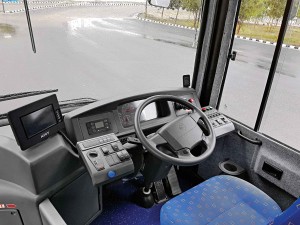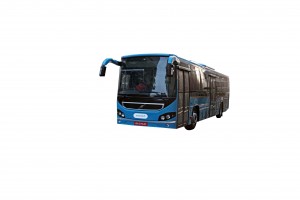Volvo Buses India is offering the 8400 low-floor hybrid city bus to help cities fight the menace of pollution.
Story by: Bhushan Mhapralkar
It is drizzling for the last one hour. Any chance of it stopping looks slim. The Vardah cyclone that devastated Chennai is showing its after effect at Bangalore. The drive to Hosakote on the outskirts of Bangalore is uneventful with tiny droplets colliding against the car windows. As the wipers work to keep the unseasonal rain from obscuring the vision of the driver, an impression is had that urbanisation is fast overtaking any attempts by the local inhabitants to carry out farming. The lure of big money from the sale of fertile parcels of land is too precious to be ignored. Described as the IT capital of India, Bangalore is perhaps the best example of how urbanisation is spreading its tentacles in every direction, bringing with it the need for efficient modes of transport. One of the modern, if not the most efficient means of transport at Bangalore are the Volvo buses. They are found the moment one steps out of the Kempegowda International Airport. The plant that manufactures these buses is where I am going. I will be spending time with the new hybrid city bus the Swedish bus major has launched. Two 12 m hybrid low-floor city buses have already been supplied to the Navi Mumbai Municipal Transport against an order of five. The third bus will soon leave Hosakote for Navi Mumbai. It is currently undergoing trials and validation. Reflecting upon Volvo’s experience in producing hybrid and electrical buses (the first hybrid bus Volvo produce is claimed to be the 2008 B5LH low-floor city bus), the low-floor hybrid city bus that I will spend time with, is a diesel-electric. It adds to the count of 6000 hybrid and electric buses Volvo has produced till date. A parallel hybrid, the bus, in terms of appearance, looks no different than the diesel powered 8400 12 m long, low-floor city bus. The Volvo 8400 diesel bus is found in over 30 cities in India.
Smart proposition
Smart the 8400 low-floor diesel city bus looks. The 8400 hybrid bus mirrors the 8400 diesel bus in appearance. The body structure is 100 per cent local, and flaunts good fit and finish levels. The use of materials, paint, and build standards hint at world-class construction. They also hint at the need the company felt in investing in a captive body building plant at Hosakote in 2008.
Based on the Volvo B5RLE platform, the 8400 hybrid city bus adds to the premise, which VRV Sriprasad, Managing Director, Volvo Buses India, describes as instrumental in persuading people to leave their vehicles behind and take to public transport. The 8400 hybrid bus seats 32 people apart from the driver. Its low-floor height makes it easier to enter and exit. There are two pneumatically operated doors on the left side of the vehicle for the purpose. With 2×2 seating arrangement, the hybrid bus, says Sriprasad, has much of its content coming from Sweden as far as the chassis is concerned. “Since the 8400 qualifies as a strong hybrid, the customer,” adds Sriprasad, “is entitled to a subsidy of Rs.61 lakhs for the bus that costs Rs.2.3 crore.”
Building on the experience of deploying hybrid buses in Australia and Singapore, Volvo in India, launched the 8400 hybrid city bus after the central government formally announced the Faster Adoption and Manufacturing of Hybrid and Electric vehicles (FAME) scheme in April 2015. The 8400 hybrid bus, it is clear, is not, about numbers. It is about providing a sustainable solution to cities battling with the issue of pollution. Claim Volvo sources, that the 8400 hybrid bus requires no supporting infrastructure. The parallel hybrid nature of the bus, they add, makes for a smart proposition. In the case of an electrical failure, the bus can still run, albeit on the diesel engine.
Smart tech
At the core of the 8400 hybrid bus is a 215 hp 5-litre Volvo D5 four-cylinder diesel engine (installed longitudinally at the rear), and a 160 hp electric motor. The engine and the motor produce a peak torque of 800 Nm each. The electric motor serves both, as a propulsion motor and as a generator. When the brakes are applied, their retardation effect is harnessed to recharge the batteries. This energy would have been wasted otherwise in the form of heat. Repeated braking, which is typical of a city-bus operation as it stops and starts, proves to be of operational benefit thus. Due to its considerable torque, the compact electric motor offers good performance at low speeds. It is at low speeds, and when the bus moves away from stand still, that the diesel engine is most taxed. It is then that it pollutes the most. Supplementing the diesel engine’s superior properties at higher speeds by producing maximum torque right from the start, the electric motor provides excellent starting characteristics and driveability. Electric power is also used when the vehicle is standing still. When the bus stops to pick up commuters or at the traffic light, the diesel engine switches off automatically. The bus, as a result, does not produce exhaust gases, and makes for a silent operation.
The motor of the 8400 hybrid bus is actually an integrated starter alternator motor (permanent magnet motor that also works as a generator and diesel engine starter motor) that runs on alternating current. The clutch and the 12-speed automatic transmission are an integral part of the driveline. The electric (electronic) unit is said to feature an energy converter for direct or alternating current and the batteries. The brain of the hybrid system is an electronic control module, which regulates the engagement and disengagement of electric and diesel power as per the need. The module also influences gear changes and battery recharging. On the 8400 hybrid bus, the power steering pump, air compressor and cooling fan are powered by separate electric motors. Each electric motor operates only when it needs to. This saves energy.
Behind the wheel
Like the diesel powered 8400 city bus, the driving position of the 8400 hybrid bus is low, and with a good view of what lies ahead. The driver cockpit is simple and functional. It is ergonomically well sorted, and has the instrument console at the centre. The console is made up of a large speedometer and tachometer dials. To the right are the air brake pressure dials. The other dials include the turbo boost pressure gauge, temperature gauge, fuel gauge and an engine oil pressure gauge. A portion of the console is occupied by an LCD readout. To the right, and adjoining the console is the parking brake switch. To the left is the AC control. Below is what could be described as a ‘pad’. It contains the transmission buttons. There are three of them. One is the ‘Drive’ button. The other two are the ‘Neutral’ and ‘Reverse’ buttons. Next to the transmission buttons is a round exterior light switch. A round blue lamp at the end of the pad indicates that this bus is hybrid by nature. It has ‘HYB’ written on it.
Turn the key, and the diesel engine wakes up to a distant growl. The management system gets down to conducting various checks. Once it is done, the diesel engine shuts down. Silence prevails. The only noise is the whine of a motor. It is indicative of an utility running. With the parking brake disengaged, all that is needed is to press the accelerator. The bus moves away, with the only indication, the rising speedo needle. It is exactly at 24 kmph that the diesel engine cuts in (the next time it cut in at 20 kmph). The tell tale indicators are a distant whine of the engine and the rising tacho needle. The motor propels the bus, and highly capably. It does so at a time when the diesel engine could be most relied upon in a diesel bus.
Speeds in the region of 50 kmph are easily achieved. The bus exhibiting good stability and a pliant ride in the process. While the air suspension is made up of sturdy air bellows, the steering provides good feedback. The auto transmission shifts cogs smoothly. No jerks are noticed as the 12-speed auto-box does its duty. The suspended driver’s seat and a fully adjustable steering position make for a comfortable driving position. The large mirrors offer a good view of what is around, and at the rear. Noise levels inside the cabin, even with the diesel engine running are low. When it is time to slow down and stop, the brakes provide a strong bite. The feel is linear and progressive. The electronically controlled disc brakes of the bus are ABS equipped. The moment the bus halts, the diesel engine goes to sleep. The muted whine of the utility motor is audible once again.
Smart, comfortable and eco-friendly
Smart the 8400 hybrid low-floor city bus is. It is modern and comfortable. It is efficient and environment friendly. Volvo sources claim that the 8400 hybrid bus offers fuel savings of up to 30 per cent higher than a diesel bus. Speeds of up to 24 kmph are attained without the diesel engine waking up. The top speed of the bus, limited to 80 kmph, presents the 8400 hybrid low-floor city bus with a good opportunity to deliver an efficient and comfortable ride. Claim Volvo sources, that the advantage a parallel hybrid bus offers over a series hybrid bus is the use of battery pack. The battery pack is not subjected to heavy use, and lasts long, they add. They also draw attention to the bus’ ability to run on diesel in case the electric (electronic) section develops a fault. It has been five months that the two hybrid buses at Navi Mumbai have been operating. The learnings will take some time coming. The buses will have to clock many more kilometers. With lower exhaust emissions during travel and zero emission when stationary, the 8400 hybrid bus makes an interesting reflection of how technology in buses is progressing.
It is afternoon by the time I depart from Hosakote. The rains have stopped. The weather has turned pleasant. The sun is out. It feels fresh. Quite unlike Mumbai where smog is often mistaken for fog, and where the room for a bus like this is only growing.

































Pingback: Volvo 8400 Hybrid Low-Floor City Bus - Tech Specs, Review | WagenClub